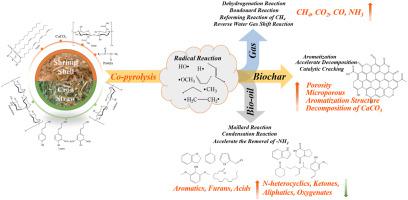Chemosphere ( IF 8.8 ) Pub Date : 2021-06-05 , DOI: 10.1016/j.chemosphere.2021.131116 Juan Liu 1 , Xiaoyu Yang 1 , Honghao Liu 1 , Xuping Jia 1 , Yongchao Bao 1

|
The co-pyrolysis characteristics of shrimp shell (SS) with corn straw (CS) were investigated by comprehensive characterization to reveal the synergistic effects and further discuss the adsorption capability. TGA results showed that pyrolysis behavior and reactivity were improved with the increase of heating rate and doping ratio of CS. Flynn-Wall-Ozawa (FWO) and distributed activation energy model (DAEM) indicated that co-pyrolysis can effectively reduce energy consumption and promote the decomposition of CaCO3. TG-FTIR and Py-GC/MS analysis indicated that the release of CH4, CO2, CO and NH3 at the doping ratio of 25% CS (75SS+25CS) was higher than that at other doping ratios, and the relative proportions of N-heterocyclics and oxygenates were lower, which was conducive to the development of pore structure for mixed biochar and effectively alleviated the pollution during co-pyrolysis process. The structure of mixed biochar was improved, confirmed by the characterizations of BET, SEM, FTIR and XRD. The mixed biochar prepared at 800 °C (75SS+25CS800) exhibited optimal porosity, aromatization and the most thorough CaCO3 decomposition. Batch adsorption experiment showed that the removal rate of 50 mg/L Cu(II) by 75SS+25CS800 was close to 100% under the dosage of 1 g/L and pH = 3–6. The adsorption process was well described by Langmuir, pseudo-second-order and Webber-Morris model, illustrating diffusion monolayer chemisorption was the main adsorption mechanism of Cu(II) on 75SS+25CS800. The maximum adsorption capacity of 75SS+25CS800 for Cu(II) was 79.77 mg/g at 35 °C. In short, this study provided a reference in optimizing the preparation process and improving the adsorption performance of mixed biochar.
中文翻译:

虾壳与玉米秸秆共热解混合生物炭:共热解特性及其吸附能力
通过综合表征研究了虾壳(SS)与玉米秸秆(CS)的共热解特性,以揭示协同效应并进一步讨论吸附能力。TGA结果表明,随着加热速率和CS掺杂比例的增加,热解行为和反应活性得到改善。Flynn-Wall-Ozawa(FWO)和分布式活化能模型(DAEM)表明共热解能有效降低能耗并促进CaCO 3的分解。TG-FTIR 和 Py-GC/MS 分析表明 CH 4、CO 2、CO 和 NH 3的释放25% CS(75SS+25CS)掺杂比例下的碳化率高于其他掺杂率,且N-杂环和含氧物的相对比例较低,有利于混合生物炭孔隙结构的发展,有效缓解共热解过程中的污染。BET、SEM、FTIR和XRD表征证实了混合生物炭的结构得到改善。在 800 °C (75SS+25CS 800 )下制备的混合生物炭表现出最佳的孔隙率、芳构化和最彻底的 CaCO 3分解。批量吸附实验表明75SS+25CS 800对50 mg/L Cu(II)的去除率在 1 g/L 的剂量和 pH = 3-6 下接近 100%。Langmuir、准二级和Webber-Morris模型很好地描述了吸附过程,说明扩散单层化学吸附是Cu(II)在75SS+25CS 800上的主要吸附机制。75SS+25CS 800对 Cu(II)的最大吸附容量为 79.77 mg/g 在 35 °C。总之,本研究为优化制备工艺、提高混合生物炭的吸附性能提供了参考。



























 京公网安备 11010802027423号
京公网安备 11010802027423号